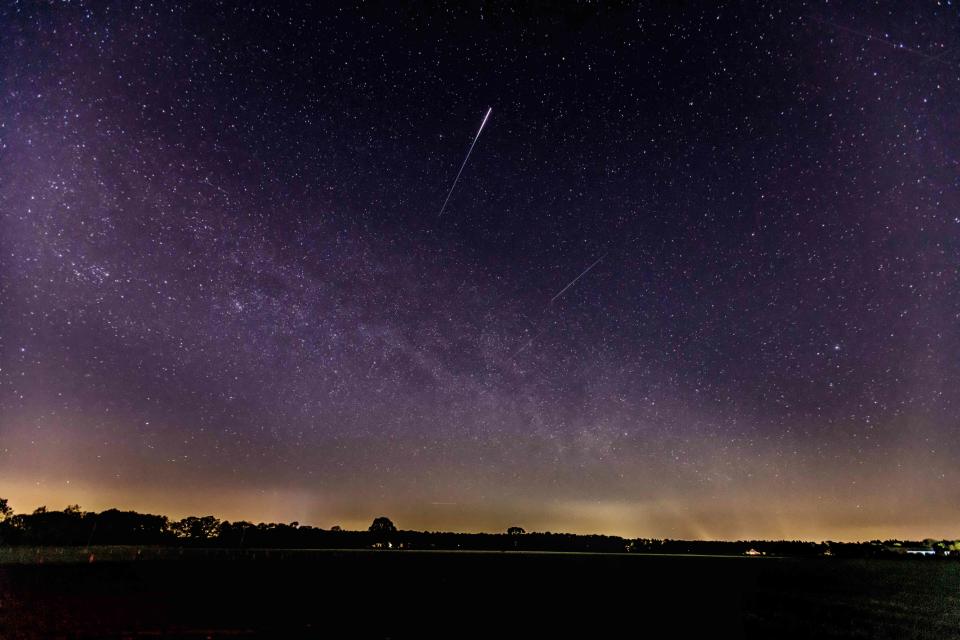You Can See the 'Pink Moon,' a Meteor Shower, and a Once-in-a-decade Eclipse This April
This month, you can spot a cluster of 800-plus stars and witness a meteor shower with up to 100 shooting stars per hour.

Getty Images
March set the night-sky bar high with an aurora borealis display that stretched as far south in the U.S. as Florida and Arizona. April’s answer? A rare solar eclipse and a meteor shower — the latter could generate up to 100 meteors per hour at its peak. Even better: The shower hits during the new moon phase, which means dark skies and enhanced shooting star displays.
April is also the tail end of the northern lights season in destinations like Alaska and Iceland. If you’re planning a last-minute trip, here are our favorite spots to scout auroras.
The month’s night sky spectacles, from planet sightings to meteor showers, will keep you busy. Here are the top events to bookmark.
April 6: Full “Pink Moon”
April’s full moon, set to glow at its brightest on April 6, is known as the "pink moon" — but it has nothing to do with its hue. According to the Ohio State University Planetarium, Native American communities called it the pink moon for the prolific spring blossoms (specifically, the pink wild ground phlox) known to bloom during the month. Indigenous coastal communities in North America also named it the “fish moon” for the American shad fish that travel upstream to spawn around this time. The new moon — the best time for dark-sky stargazing — hits on April 20.
April 10-11: Venus approaches Pleiades
Venus, our solar system’s brightest planet, will glow within roughly 2 degrees of the Pleiades star cluster this month, according to EarthSky.org. (The Pleiades are a group of more than 800 stars located about 410 light-years from Earth.) Stargazing app SkySafari told Travel & Leisure that the two will technically be visible from April 7 through April 14, but the best viewing occurs from April 10 to April 11. To see this event, look to the western sky after sunset in the Northern Hemisphere. Until roughly 10 p.m. EDT, Uranus and Mercury will hover near the horizon below Venus, while Mars will shine above Venus and the Pleiades. Though you can spot these planets with your naked eye, a pair of stargazing binoculars or a telescope will enhance the view.
April 11: Mercury Sighting
Mercury will be easier to see throughout the month as it travels higher in the sky, according to SkySafari. The planet reaches its highest point in the evening sky on April 11, when it will be roughly 19.5 degrees from the sun. You can spot the fast-moving planet with your bare eyes, but a telescope is required to see its disk. After April 11, it'll be trickier to spot the planet — it will dim as it travels toward the sun.
April 20: A rare hybrid solar eclipse
April will welcome a rare, once-in-a-decade spectacle: a hybrid solar eclipse. (A total solar eclipse happens when the moon completely blocks the face of the sun, and an annular solar eclipse occurs when the moon is further from Earth and only covers a portion of the sun. A hybrid solar eclipse, as the name suggests, is a blend of the two.) According to NASA, Earth’s curved surface causes a hybrid eclipse to shift between an annular and total eclipse as the moon moves across the sun. It only occurs a few times per century, and this month’s display will be visible in remote stretches of the Southern Hemisphere, largely at sea. The best viewing locales include Western Australia, Timor-Leste, and West Papua, according to Sky at Night Magazine. (Catch a livestream of the event at TimeAndDate.com's YouTube channel.)
April 21: Lyrid Meteor Shower
The Lyrid meteor shower couldn’t have better timing this year. It coincides with a waning gibbous moon — this means the moon is less visible so the skies are darker than normal. If clouds cooperate, the meteor shower may welcome up to 100 meteors per hour at its peak from April 21 through April 23. That said, 10 to 20 meteors per hour is more likely, according to EarthSky.org. You can start watching for the shooting stars in the late evening on April 21 through dawn on April 22, and then again in the evening of April 22 through April 23. To spot the streaks, look for the Vega star in the Lyra constellation from the Northern Hemisphere. “The higher Vega appears in your sky, the more meteors you’re likely to see,” EarthSky.org reported. Its next above-average outburst is expected for 2042.
For more Travel & Leisure news, make sure to sign up for our newsletter!
Read the original article on Travel & Leisure.

 Yahoo Autos
Yahoo Autos